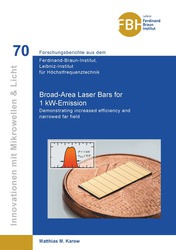| Areas | |
|---|---|
| Serie de libros (96) |
1378
|
| Nachhaltigkeit |
3
|
| Gesundheitswesen |
1
|
| Letra |
2364
|
| Ciencias Naturales |
5406
|
| Ciencias Ingeniería |
1793
|
| Ingeniería | 292 |
| Ingeniería mecánica y de proceso | 862 |
| Ingeniería eléctrica | 686 |
| Mineria y metalurgía | 30 |
| Arquitectura e ingeniería civil | 75 |
| General |
98
|
|
Leitlinien Unfallchirurgie
5. Auflage bestellen |
|
Erweiterte Suche
Broad-Area Laser Bars for 1 kW-Emission (Volumen 70) (Tienda española)
Demonstrating increased efficiency and narrowed far field
Matthias M. Karow (Autor)Previo
Lectura de prueba, PDF (820 KB)
Indice, PDF (26 KB)
Industrial laser systems for material processing applications rely on the availability of highly efficient, high-brightness diode lasers. GaAs-based broad-area laser bars play a vital role in such applications as pump sources for high-beam-quality solid-state lasers and, increasingly, as direct processing tools.
This work studies 940 nm-laser bars emitting 1 kW optical power at room temperature, identifying those physical mechanisms that are currently limiting electrical-to-optical conversion efficiency as well as lateral beam quality. In the process, several diagnostic studies on bars with varied lateral-longitudinal design were carried out. The effects of technological measures for performance optimization were analyzed, yielding a new benchmark in efficiency and lateral divergence.
The studies into altered resonator lengths of 4 and 6 mm as well as fill factors between 69 and 87 % successfully reduce both the voltage dropping across the device and power saturation at high currents, enabling 66 % efficiency at the operation point. Concrete measures how to reach efficiencies ≥70 % are presented thereafter, showing that doubling the efficiency value of the first 1 kW-demonstration in 2007 – amounting to 35 % – is in near reach.
Investigation of the beam quality bases on a herein proposed and realized concept, in which the far field is resolved for each individual bar emitter. In this way, it is possible to determine how far-field profiles vary along the bar width and how much these variations affect the overall bar far-field. Further, such effects specific to bar structures can be separated into non-thermal and thermal influences. The effect of mechanical chip deformation (bar smile) as well as neighboring-emitter interaction has been investigated for the first time in active kW-class devices, yielding a lateral divergence as low as 8.8° at the operation point.
| ISBN-13 (Impresion) | 9783736976269 |
| ISBN-13 (E-Book) | 9783736966260 |
| Formato | A5 |
| Idioma | Inglés |
| Numero de paginas | 142 |
| Laminacion de la cubierta | mate |
| Edicion | 1. |
| Serie | Innovationen mit Mikrowellen und Licht. Forschungsberichte aus dem Ferdinand-Braun-Institut, Leibniz-Institut für Höchstfrequenztechnik |
| Volumen | 70 |
| Lugar de publicacion | Göttingen |
| Lugar de la disertacion | Berlin |
| Fecha de publicacion | 27.06.2022 |
| Clasificacion simple | Tesis doctoral |
| Area |
Ingeniería eléctrica
|
| Palabras claves | diode laser, high power, high brightness, narrow far field, high efficiency, kW-class, laser bar, material processing, laser pumping, solid-state laser, thin-disk laser, Yb:YAG laser, near-infrared, thermal engineering, thermal waveguide, thermal lens, bar smile, lateral structure, resonator length, industrial laser, broad-area laser, EDAS, beam quality, vertical structure, thermal transient, cross heating, bar edge, sub-structure, deep implantation, chip strain, chip stress, strain-induced waveguide, strain-induced birefringence, strain-induced dichroism, chip mounting, chip soldering, characteristic thermal length, high fill factor, beam quality test station, thermal impedance, thermal resistance, index-guiding trench, emitter resolved, laser array, Diodenlaser, Hochleistung, hochbrillant, schmales Fernfeld, hocheffizient, kW-Klasse, Laserbarren, Materialbearbeitung, Laserpumpen, Festkörper-Laser, Dünnscheiben-Laser, Yb:YAG-Laser, nah-infrarot, thermisches Designen, thermischer Wellenleiter, thermische Linse, Barren-Smile, laterale Belegung, Resonatorlänge, industrieller Laser, Breitstreifen-Laser, EDAS, Strahlgüte, Vertikalstruktur, thermische Transiente, Gegen-Erwärmung, Barren-Kante, Substruktur, Tiefe Implantierung, Chip-Dehnung, Chip-Verspannung, Verspannungs-induzierter Wellenleiter, Verspannungs-induzierte Doppelbrechung, Verspannungs-induzierter Dichroismus, Chip-Aufbau, Chip-Lötung, characteristische thermische Länge, hoher Füllfaktor, Strahlgüte-Messplatz, thermische Impedanz, thermischer Widerstand, Indexleiter-Graben, Emitter-aufgelöst, Laser-Array |
| URL para pagina web externa | https://www.fbh-berlin.de/publikationen/dissertationen |
Rezension
Broad-Area Laser Bars for 1 kW-Emission with High Efficiency and Narrow Far Field
by M. Karow
Matthias Karow dealt with the optimization of GaAs-based high-power diode laser bars. His aim was to increase the conversion efficiency and the maximum output power of broad area laser diodes and to better understand the factors influencing the far field distribution and the beam quality of laser bars. Mr. Karow solves these questions through a combination of design studies, the analysis of physical mechanism as well as the systematic variation of process technologies and layout of the diode laser bars. The results of his work form an important basis for the development of highly efficient diode laser bars with peak kW power, which are used in a wide range of applications, e.g. for material processing, such as laser cutting and laser welding. Therefore it is no surprise that this work was created in close cooperation with TRUMPF Laser GmbH, one of the world's largest suppliers of laser-based machine tools. Especially in a research area in which the technological development has reached a high level of maturity, it is essential to pay considerable attention to the smallest details in the development chain. Mr. Karow has successfully accepted this challenge and his book provides a systematic and careful study of the influence of the laser design and the fabrication processes on output power, conversion efficiency and far-field distribution of GaAs-based high-power laser diodes.
Prof. Dr. Michael Kneissl
Technical University Berlin
Institute of Solid State Physics








